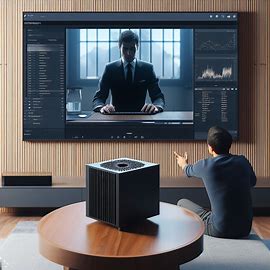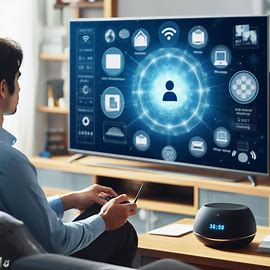Easily Connect Your Mini PC to Your Smart TV: A Comprehensive Guide for Wireless Mirroring

In today’s tech-savvy world, the ability to connect devices seamlessly is more important than ever. This guide focuses on mini-PCs and how to use wireless screen mirroring to connect them to Smart TVs. This technique of a wireless PC to TV connection offers a clutter-free and advanced solution for screen mirroring. While this article primarily addresses mini PCs, it’s worth noting that the process is quite similar for laptops or desktops.
The charm of a mini PC lies in its compact size coupled with powerful capabilities. Whether you’re looking to enjoy movies on a bigger screen, share presentations, or amplify your gaming experience, connecting your mini PC to your Smart TV wirelessly is a smart move. This guide will walk you through the necessary steps. It starts from preparing your devices to troubleshooting common issues, ensuring a smooth and enjoyable viewing experience.
What Will This Article Will Tell You?
This article provides a thorough guide on wirelessly connecting a mini PC to a Smart TV. It covers the basics of wireless screen mirroring technology, comparing it to traditional HDMI connections for context. Key steps to prepare both the mini PC and Smart TV for wireless connectivity are outlined, including compatibility checks and necessary settings. The article offers a detailed walkthrough for setting up the connection, with tips on using native Windows features, third-party apps, and devices like Chromecast. It also addresses common connection issues and their solutions. Beyond the setup, the guide delves into optimizing and securing the wireless connection for better performance and safety. Alternatives like HDMI are discussed for situations where wireless might not be the best choice. Overall, the article is a comprehensive resource for anyone looking to enhance their mini PC and Smart TV experience through wireless screen mirroring.
Stay tuned as we explore various methods, including the use of HDMI, Chromecast, and native Windows 10 and Windows 11 features. We’ll also cover essential aspects like security, optimization tips, and when to opt for alternatives like HDMI cables. So, get ready to transform your entertainment and work setups by seamlessly mirroring your mini PC to your Smart TV.
Understanding Wireless Screen Mirroring
In an era where flexibility and convenience are paramount, understanding the nuances of wireless screen mirroring becomes essential. This technology has evolved rapidly, offering an innovative way to connect devices like mini PCs to TVs. Let’s dive into the technology that powers this feature and compare it with traditional wired methods.
The Technology Behind Wireless Screen Mirroring
Wireless screen mirroring, a revolutionary technology in the realm of digital connectivity, allows you to display the content of your mini PC on a TV screen without the need for physical cables. This technology harnesses wireless networks to transmit audio and video data from your PC to your TV. It’s a feature that has become increasingly popular, especially with the advent of smart TVs and the growing capabilities of mini PCs.
At its core, wireless screen mirroring involves encoding and transmitting data wirelessly. Technologies like Wi-Fi Direct, Miracast, Apple TV for macOS users, and various proprietary systems from TV manufacturers play a crucial role. When you initiate screen mirroring, your mini PC sends a signal that is captured by your Smart TV, allowing it to display your PC’s screen in real-time.
Wired (HDMI) vs. Wireless Connections
The traditional method of connecting PCs to TVs has been through wired connections, primarily using HDMI cables. HDMI, which stands for High-Definition Multimedia Interface, provides a reliable, high-quality video and audio connection. However, HDMI requires a physical cable, which can be restrictive and lead to a cluttered setup.
In contrast, wireless screen mirroring offers a level of convenience and flexibility that HDMI cannot match. While HDMI provides a stable connection that is less susceptible to interference, wireless methods offer the freedom to connect devices without worrying about cable lengths, port availability, or the unsightly mess of wires.
Benefits of Connecting a Mini PC to TV Wirelessly
The transition from traditional wired connections to wireless technology is more than just a shift in how we connect devices; it represents a significant advancement in our interaction with technology. Particularly for mini PC users, this wireless capability opens up a new realm of possibilities. Let’s explore the specific benefits that wireless screen mirroring brings to mini PC users, from a clutter-free environment to enhanced flexibility and usability.
Clutter-Free Setup and Flexibility
One of the most appealing advantages of using wireless technology to connect your mini PC to your Smart TV is the elimination of cables. This results in a cleaner, more organized space, whether it’s your living room, bedroom, or a conference room. Additionally, wireless connections offer flexibility in terms of setup. You are no longer constrained by the length of an HDMI cable or the need to keep devices in close proximity.
Tailored Benefits for Mini PCs
Mini PCs, known for their compact size and portability, stand to gain significantly from wireless screen mirroring. This technology complements the minimalist and space-saving design of mini PCs, allowing them to easily integrate into home entertainment systems or professional environments without adding to the clutter. Moreover, for users who frequently move their mini PCs between different locations or rooms, the ability to connect wirelessly to various TVs offers unparalleled convenience and enhances the utility of these compact devices.
In summary, wireless screen mirroring not only modernizes the way we connect devices but also aligns perfectly with the evolving design and functionality of mini PCs, offering an efficient, clean, and flexible way to expand their display capabilities.
Preparing Your Mini PC and Smart TV for Wireless Connection
Before diving into the world of wireless screen mirroring, it’s crucial to ensure that both your mini PC and Smart TV are properly set up and ready for the task. This preparation is key to a smooth and successful connection. For mini PCs, particularly those running Windows 10, there are specific steps and settings to consider.
Ensuring Your Mini PC is Ready
- Update Your Operating System: Make sure your Windows 10 desktop or any other operating system on your mini PC is up to date. This ensures compatibility with the latest wireless display technologies.
- Check Wireless Capabilities: Verify that your mini PC’s wireless adapter is enabled and functioning. This might involve checking driver updates or ensuring that the hardware supports wireless display technologies like Miracast.
- Network Connectivity: A stable Wi-Fi connection is essential. Your mini PC should be connected to the same wireless network as your Smart TV for seamless mirroring.
Preparing Your Smart TV
- Firmware Updates: Regularly update your Smart TV’s firmware to the latest version. This can improve compatibility and introduce new features for wireless connectivity.
- Enable Screen Mirroring Features: Navigate through your TV’s settings to enable screen mirroring or wireless display options. This might be labeled differently depending on the TV brand.
- Network Connectivity: Just like the mini PC, ensure your Smart TV is connected to the same Wi-Fi network.
Compatible Devices and Software
The compatibility of devices plays a pivotal role in the success of wireless screen mirroring. While most modern mini PCs and Smart TVs support this feature, it’s essential to verify this beforehand.
Mini PCs Known for Compatibility
- Popular Brands: Brands like Intel NUC, ASUS VivoMini, and HP EliteDesk offer mini PCs that typically support wireless display technologies.
- Windows 10 Compatibility: Windows 10 or Windows 11 desktops generally support Miracast, a standard wireless connection method, making them suitable for screen mirroring.
Smart TVs and Software Requirements
- Smart TV Brands: Samsung, LG, Sony, and Panasonic are some of the brands known for Smart TVs that support wireless mirroring.
- Software and Apps: Some TVs may require specific apps or software for mirroring, such as Google Home for Chromecast. Check your TV’s manual or online resources for specific requirements.
Ensuring compatibility and proper setup of both your mini PC and Smart TV not only facilitates a seamless connection but also enhances the overall experience of wireless screen mirroring.
How to Connect Your Mini PC to Your Smart TV Wirelessly
Achieving a wireless connection between your mini PC and Smart TV can seem daunting, but with the right steps, it’s a straightforward process. This section provides a step-by-step guide to help you establish this connection smoothly, covering various methods including native Windows features, third-party apps, and devices like Chromecast.
Connect Using Native Windows 11 Features
- Ensure Both Devices are on the Same Wi-Fi Network: This is crucial for the connection.
- Access the ‘Connect’ Feature: On your Windows 10 mini PC, use the shortcut
Windows Key + Kto open the wireless display interface. - Select Your TV: Your Smart TV should appear in the list of available devices. Select it to start the mirroring process.
- Follow On-Screen Instructions: Both your PC and TV might provide prompts to complete the connection.
Using Third-Party Apps
- Download a Compatible App: Apps like AirDroid Cast Web can facilitate screen mirroring. Ensure the app is installed on both your mini PC and Smart TV.
- Open the App and Connect: Follow the app’s instructions to connect your PC to your TV.
Using Devices Like Chromecast
- Plug Chromecast into Your TV: Insert it into an available HDMI port.
- Set Up Chromecast: Follow the setup process using the Google Home app on your mini PC.
- Cast Your Screen: In the Google Home app, select your TV and choose the option to cast your screen.
Troubleshooting Common Connection Issues
Even with the correct setup, you might encounter issues during the screen mirroring process. Here are some common problems and their solutions.
TV Not Recognizing the Mini PC
- Solution: Check if both devices are on the same Wi-Fi network. Restart both devices and attempt the connection again.
Poor Quality or Lag in Mirroring
- Solution: This can often be due to a weak Wi-Fi signal. Try moving the mini PC closer to the router or consider using a Wi-Fi extender.
Connection Drops Frequently
- Solution: Ensure there are no large physical obstructions between your mini PC and Smart TV or router. Also, check for other devices that might be causing interference.
No Sound During Mirroring
- Solution: Check the sound settings on both your mini PC and TV. Ensure the TV is selected as the default audio output device on your PC.
By following these steps and troubleshooting tips, you should be able to successfully and efficiently set up a wireless screen mirroring connection between your mini PC and Smart TV, enhancing your viewing and streaming experiences.
Enhancing Your Wireless Connection Experience
Once you have successfully established a wireless connection between your mini PC and Smart TV, the next step is to enhance this experience. Optimizing your screen mirroring setup can significantly improve the quality of the content you’re streaming or presenting, and can also make your gaming sessions more enjoyable.
Optimizing Network Performance
- Strengthen Wi-Fi Signal: A strong Wi-Fi signal is key to a smooth mirroring experience. Consider using a Wi-Fi extender or upgrading your router to ensure a robust connection.
- Limit Network Traffic: If possible, reduce other heavy internet usage on your network while mirroring, as this can affect connection quality.
Adjusting Display Settings
- Resolution Settings: Adjust the display settings on your mini PC to match your TV’s resolution for optimal viewing quality.
- Audio Configuration: Ensure the audio output on your mini PC is configured to use your TV’s speakers for a better sound experience.
Suggestions for Uses
- Streaming: Enjoy your favorite movies and shows on a larger screen for an immersive viewing experience.
- Gaming: Play your PC games on your TV for enhanced graphics and a larger display.
- Presentations: Use your TV as a secondary screen for presentations, providing a clear view for larger audiences.
Securing Your Wireless Screen Mirroring Setup
While wireless screen mirroring offers convenience and flexibility, it’s important to consider the security aspects of such connections, especially in terms of privacy and data protection.
Ensuring Network Security
- Protected Wi-Fi Network: Always use a secure, password-protected Wi-Fi network to prevent unauthorized access.
- Regular Updates: Keep your mini PC and Smart TV’s software updated to protect against vulnerabilities.
Privacy Considerations
- Secure Connection Methods: Use trusted screen mirroring methods and avoid third-party apps that aren’t well-known or lack security features.
- Disconnect When Not in Use: Remember to disconnect the screen mirroring once you’re done, especially if sensitive information was displayed.
By following these tips and being mindful of security, you can significantly enhance and secure your wireless screen mirroring experience, making the most out of your mini PC and Smart TV capabilities.
Alternatives to Wireless Mirroring: When to Connect a Mini PC Your TV via HDMI
Wireless screen mirroring offers convenience and flexibility, but there are scenarios where a traditional TV connection via HDMI might be more suitable. Understanding these situations and the comparative advantages of HDMI connections can help you make the best choice for your needs.
Scenarios Favoring HDMI Connections
- High-Quality Streaming and Gaming: For ultra-high-definition content or high-end gaming, HDMI can provide a more stable and higher quality connection, ensuring no lag or loss in picture quality.
- Confidential Presentations: In professional settings where security is paramount, a direct HDMI connection can be more secure, as it’s less susceptible to interception.
- Environment with Heavy Wireless Interference: In areas with heavy Wi-Fi congestion or interference, an HDMI connection can offer a more reliable alternative.
Quality and Reliability: Wireless vs. HDMI
- Quality of Connection: HDMI generally offers a higher and more consistent quality of video and audio transmission, especially beneficial for 4K content or high-fidelity audio.
- Reliability: HDMI connections are less prone to interruptions compared to wireless connections, which can be affected by factors like network strength, interference, and compatibility issues.
- Latency: For activities requiring real-time responses, such as competitive gaming or live performances, HDMI’s lower latency is a significant advantage.
While wireless screen mirroring is a great feature for many applications, HDMI remains a strong contender in scenarios demanding the highest quality, security, and reliability. Understanding the strengths and limitations of both wireless and HDMI connections allows you to choose the best method for your specific situation, be it for entertainment, work, or gaming with your mini PC and Smart TV.
Conclusion: Maximizing Your Mini PC’s Potential with Smart TV Wireless Connections
As we conclude our exploration into connecting mini PCs to Smart TVs wirelessly, let’s reflect on the key insights gained and the exciting possibilities this technology offers.
Key Takeaways and Future Possibilities
- We’ve delved into the essence of wireless screen mirroring, understanding its technology, and how it stands in comparison to HDMI connections.
- The importance of preparing both your mini PC and Smart TV for a seamless wireless experience was highlighted, along with a guide on compatible devices and software.
- Practical steps for connecting your mini PC to your Smart TV wirelessly were provided, ensuring you can effortlessly enjoy streaming, gaming, and more.
- We also discussed optimizing and securing your wireless connection, ensuring both enhanced performance and protection.
- For scenarios where wireless isn’t ideal, the relevance of HDMI connections was acknowledged, emphasizing their role in high-quality and secure transmissions.
Frequently Asked Questions
What is wireless screen mirroring?
Wireless screen mirroring is a technology that allows you to display your mini PC’s screen on a Smart TV without using any physical cables, transmitting audio and video data wirelessly through your home network.
Do all mini PCs support wireless screen mirroring?
Not all mini PCs support wireless mirroring. Compatibility depends on the device’s wireless capabilities, operating system (Windows 10/11 works best), and built-in wireless adapters. Popular brands like Intel NUC, ASUS VivoMini, and HP EliteDesk typically support this feature.
What do I need to mirror my mini PC to a Smart TV?
You’ll need:
– A mini PC with wireless capabilities
– A Smart TV that supports screen mirroring
– Both devices connected to the same Wi-Fi network
– Compatible screen mirroring technology (Miracast, Chromecast, etc.)
How do I fix poor quality or lagging during screen mirroring?
To improve connection quality:
– Ensure a strong Wi-Fi signal
– Move your mini PC closer to the router
– Use a Wi-Fi extender
– Reduce other network traffic
– Update device firmware and drivers
Is wireless screen mirroring secure?
Wireless mirroring can be secure if you:
– Use a password-protected Wi-Fi network
– Keep your devices’ software updated
– Disconnect mirroring when not in use
– Use trusted mirroring methods and apps
Embracing Wireless Mirroring with Your Mini PC

The journey from traditional wired setups to wireless connections is not merely a technological upgrade but a step into a more flexible and efficient digital lifestyle. Whether for entertainment, work, or creativity, the ability to connect your mini PC to your Smart TV wirelessly can transform your experience. We encourage you to embrace this innovation, unlocking new levels of convenience and potential in your mini PC’s capabilities. Let this guide be your starting point in harnessing the full power of wireless technology for your mini PC and Smart TV setup.

I am a retired software engineer with experience in a multitude of areas including managing AWS and VMWare development environments. I bought a relative a mini-PC a year ago and have become passionate about the technology and its potential to change how we deploy software.
